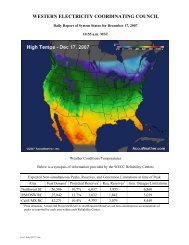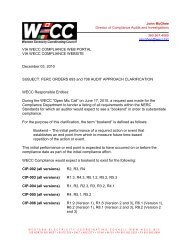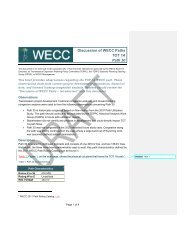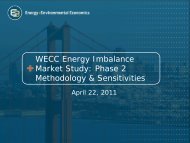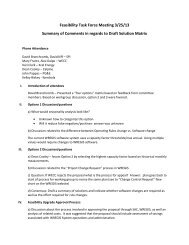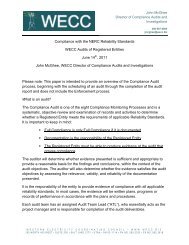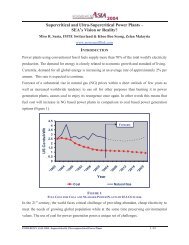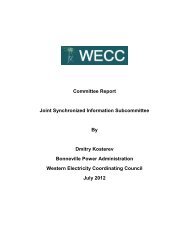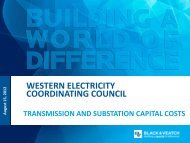Path Rating Catalog 2013 - Western Electricity Coordinating Council
Path Rating Catalog 2013 - Western Electricity Coordinating Council
Path Rating Catalog 2013 - Western Electricity Coordinating Council
You also want an ePaper? Increase the reach of your titles
YUMPU automatically turns print PDFs into web optimized ePapers that Google loves.
Revised January <strong>2013</strong><br />
System<br />
Conditions:<br />
Study Criteria:<br />
Remedial<br />
Actions<br />
Required:<br />
Formal<br />
Operating<br />
Procedure:<br />
Allocation:<br />
Interaction<br />
w/Other<br />
Transfer <strong>Path</strong>s:<br />
North to South: The two Custer-Ingledow tielines can transmit 2850 MW<br />
from Canada to the Northwest when BC Hydro’s load (Canada) is between<br />
approximately 40% and 70% of its annual peak load.<br />
South to North: Restrictions occur during winter peak demand periods due to<br />
thermal and voltage stability concerns in the Northwest and British Columbia.<br />
However, predominant transfers occur during spring months when voltage<br />
stability limitations are not a concern in northwest Washington. Restrictions<br />
also occur when Puget Sound area generation level is low in both heavy<br />
summer and winter load conditions.<br />
1. “BCH System Operating Limits Methodology”, SPA Report No.<br />
SPA2008-02, 15 December 2009.<br />
2. WECC Regional Criteria TPL-(001 thru 004) – WECC-1-CR ─ System<br />
Performance Criteria<br />
North to South: The 230 kV tie lines are directly transfer tripped after loss of<br />
both 500 kV Ingledow-Custer ties when the North to South total transfer<br />
exceeds 400 MW, thus separating the Northwest from Canada. The maximum<br />
amount of generator tripping in Canada (B.C. Hydro) is about 110% of the<br />
scheduled export from Canada to the Northwest. Reactive power equipment<br />
switching scheme is used in BC Hydro (Canada) to control over voltages for<br />
loss of both 500 kV Ingledow – Custer ties when the transfer on the<br />
Ingledow-Custer tie lines is between 2000 and 2850 MW. Certain Northwest<br />
Washington area contingencies require generation tripping in Canada when<br />
flows are above 800 MW. This generation trip is never more than 1850 MW.<br />
Puget Sound Energy generation tripping is also armed at Whitehorn and<br />
Fredonia for some of these contingencies.<br />
South to North: The 230 kV tielines are directly tripped after outages of both<br />
500 kV Ingledow-Custer ties when the South to North total transfer exceeds<br />
400 MW, thus separating the Northwest from Canada. In addition, the BCH –<br />
AB tie lines will be tripped open after loss of both 500 kV Ingledow-Custer<br />
ties when BCH net importing is high<br />
B.C. Hydro’s System Operating Order #7T-18 “Custer-Ingledow 500 kV<br />
Interconnection,” and #7T-64 “BC HYDRO TRANSFER LIMITs”<br />
BPA Dispatcher Standing Order #320 “Operation of the Northern Intertie”<br />
and Standing Order #323 “Bellingham Area-Intalco Load Tripping.”<br />
North to South: All of the capacity is allocated to B. C. Hydro, BPA, and<br />
PSE.<br />
South to North: All of the capacity is allocated to B.C. Hydro, BPA, and<br />
PSE.<br />
North to South: For the Ingledow-Custer intertie 2850 MW accepted rating,<br />
there is a potential interaction with the Raver-Paul loading.<br />
South to North: For the Ingledow-Custer intertie 2750 MW accepted rating<br />
there is a potential interaction with PDCI N-S and COI N-S transfers at higher<br />
levels.<br />
PART VI Item 1-10



